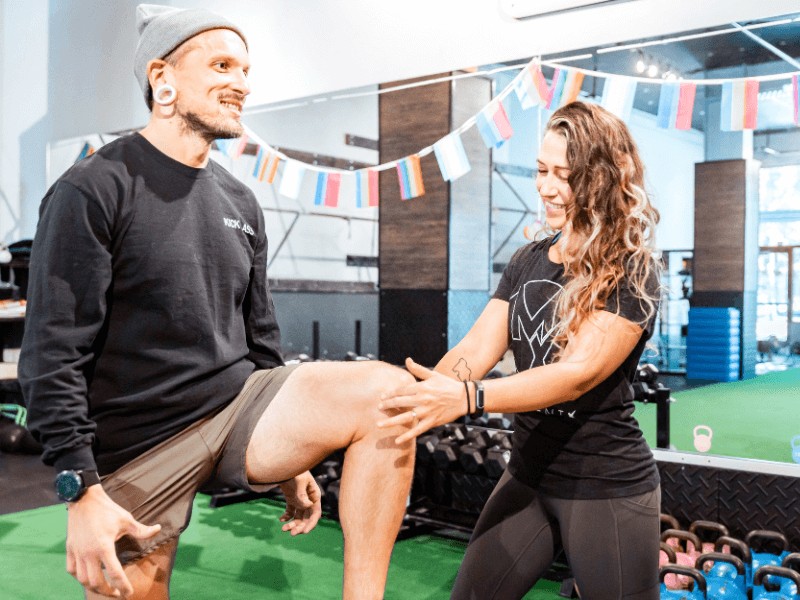Shoulder Pain Explained: How Physical Therapy Can Get You Moving Again
Whether it’s a sharp twinge when you lift your arm or a persistent ache that makes everyday tasks difficult, shoulder pain affects people of all ages and activity levels. It can limit your range of motion, strength, and make it hard to stay active and independent.
Studies show that shoulder pain generally accounts for approximately 18-26% of all musculoskeletal complaints, making it one of the most frequent reasons people seek physical therapy care.
Whether your pain stems from an injury, overuse, or a degenerative condition, it’s important to address the issue early to prevent further damage or chronic discomfort. Without the right care, shoulder pain can worsen over time, potentially leading to more serious complications like frozen shoulder or rotator cuff tears.
This page will guide you through a better understanding of shoulder pain, its common causes and symptoms, as well as the various treatment options available. Most importantly, we’ll explain how physical therapy can help you regain the strength and confidence you need on your path to long-term recovery.
Read on to discover how physical therapy can get you back to moving freely and living pain-free!
What is Shoulder Pain?
The shoulder is one of the most mobile joints in the body, allowing for a wide range of motion for activities like lifting, reaching, and throwing. However, this complexity also makes it vulnerable to injury, overuse, and degeneration.
Discomfort or limitation in the shoulder joint or surrounding tissues can develop suddenly due to an acute injury or gradually over time from repetitive strain. Shoulder pain can stem from various underlying issues, such as inflammation of the rotator cuff tendons, joint instability, or arthritis. Because the shoulder is critical for many upper body movements, pain in this area can quickly diminish your ability to function at your best.
Shoulder pain can range from mild discomfort to severe, debilitating pain that dramatically affects the use of your arm. Simple activities like dressing, carrying groceries, or even sleeping can become difficult when more pronounced pain levels are present. If left untreated over time, pain can lead to loss of mobility, decreased strength, and reduced independence.
Symptoms of Shoulder Pain
Shoulder pain can manifest in various ways, and its severity often depends on the underlying cause. Some people experience mild discomfort that comes and goes, while others may deal with persistent, more intense pain that interferes with daily activities. Recognizing the most common symptoms can help prevent further complications and aid in seeking appropriate treatment:
- Pain with Movement: You may feel discomfort when lifting your arm, reaching overhead, or moving your shoulder in certain directions. Pain might also worsen during specific activities like throwing, pushing, or pulling.
- Stiffness and Limited Range of Motion: The shoulder might feel stiff and make it difficult to move your arm fully. In some cases, you might experience what is commonly called a “frozen shoulder” where movement is severely restricted.
- Weakness in the Shoulder or Arm: You may notice a reduction in strength when lifting objects or holding them at shoulder height (this position places a good demand on shoulder musculature).
- Swelling or Tenderness: The area around your shoulder joint might feel swollen or tender to the touch, especially after activity or injury. This can sometimes be a sign of inflammation in the tendons or muscles.
- Clicking or Popping Sounds: Some people report hearing or feeling a clicking, popping, or grinding sensation when moving their shoulder. A health professional may suspect this could be related to joint instability or damage to the joint cartilage or tendons.
- Pain While Sleeping: Shoulder pain may worsen at night, particularly if you sleep on the affected side. This can lead to disrupted sleep and difficulty finding a comfortable position.
- Radiating Pain: Shoulder pain can sometimes spread from the joint down the arm, or even toward the neck or upper back. This is often due to nerve involvement or referred pain from other areas.
- Difficulty Performing Daily Tasks: Shoulder pain can make it harder to perform routine activities, like reaching behind your back, brushing your hair, or even dressing.
Note: It’s important to seek professional care if you are experiencing any of these symptoms, especially if they persist or worsen over time!
Causes of Pain in the Shoulder
Several lifestyle habits, conditions, or injuries may contribute to shoulder pain. Understanding these potential causes can help identify what might be triggering your discomfort and guide you toward appropriate treatment.
Here are some common causes and risk factors that are sometimes linked to shoulder pain:
- Overuse or Repetitive Movements: Without proper conditioning, repeated overhead movements, such as throwing, lifting, or reaching, can strain the shoulder muscles and tendons over time. Athletes, manual laborers, or even those with desk jobs that require repetitive motions may be more prone to developing shoulder pain.
- Rotator Cuff Injuries: The rotator cuff is a group of four muscles and tendons that act together to stabilize the shoulder joint. Tears, strains, or inflammation of these tendons can result in significant pain and limited mobility.
- Shoulder Impingement: This occurs when the tendons of the rotator cuff are compressed or pinched between the bones or cartilage of the shoulder joint. Impingement can lead to pain, weakness, and difficulty raising the arm.
- Arthritis: Shoulder pain may develop due to osteoarthritis, where the cartilage in the shoulder joint gradually wears and can lead to inflammation, stiffness, and discomfort.
- Shoulder Instability: The shoulder joint is inherently very mobile, but sometimes it can be hypermobile. Some people may experience instability in the shoulder joint, either due to previous injuries, disclocations, or common hypermobility conditions like EDS or HSD.
- Bursitis: The shoulder area contains small, fluid-filled sacs called bursae that cushion and reduce friction between muscles, tendons, and bones. When these sacs become inflamed, a condition known as bursitis, it can result in pain, particularly when moving the arm or lying on the affected side.
- Tendonitis: Shoulder tendonitis is the inflammation or irritation of the tendons in the shoulder, often resulting from overuse or injury. This condition can cause pain, swelling, and difficulty with various arm movements.
- Trauma or Injury: Fractures, sprains, or dislocations can cause sudden shoulder pain. Accidents, falls, or sports are common culprits of these acute injuries.
- Postural Issues: Poor sitting or standing posture can sometimes lead to shoulder pain by placing undue strain on the surrounding muscles and tendons.
- Nerve Compression: Occasionally, shoulder pain may actually be the result of a pinched nerve in your neck or upper back. This can cause pain that radiates into the shoulder, often referred to as referred pain or radiating pain.
Treatment Options for Shoulder Pain
The best treatment for shoulder pain depends on your unique underlying cause, severity, and duration of symptoms. Fortunately, a range of treatment options are available, from conservative approaches like physical therapy to more invasive procedures. Here’s an overview of the most common treatment options:
- Activity Modification: In many cases, simply modifiying activities that aggravate your pain can help reduce symptoms. While being mindful of your posture, optimizing your lifting/carrying technique, or conditioning your shoulder muscles can be helpful, it’s important to avoid negative compensatory behaviors (not using your painful arm as much, etc). Recent studies have shown that shoulder slings or immobilization braces are not effective in most cases.
- Physical Therapy: Physical therapy is often one of the most effective non-invasive treatments for shoulder pain. Here at MovementX, your physical therapist will design a personalized exercise and rehabilitation program to improve strength, flexibility, and range of motion while addressing any underlying biomechanical issues. Manual therapy, stretches, and strengthening exercises play a key role in reducing pain and restoring normal function.
- Medications: Over-the-counter anti-inflammatory medications such as ibuprofen may help reduce pain and inflammation associated with certain shoulder conditions like tendonitis or bursitis. In some cases, your doctor may prescribe stronger pain medications or muscle relaxants if needed for more severe symptoms.
- Corticosteroid Injections: For persistent or severe shoulder pain that doesn’t respond to initial physical therapy treatment, corticosteroid injections can sometimes provide relief by reducing inflammation within the joint or surrounding tendons. However, they are typically a short-term solution and are not recommended for frequent use due to potential side effects.
- Heat and Ice Therapy: Applying ice to the shoulder can help reduce swelling and numb acute pain, especially following an injury or after strenuous activity. Heat therapy, on the other hand, can help relax tight muscles and improve blood flow.
- Surgery: Surgery may be considered for more severe conditions like rotator cuff tears or advanced arthritis where all other conservative treatments fail. These range from minimally invasive arthroscopic procedures, which involve small incisions to repair damaged tissue, to total shoulder replacement, which may be necessary for patients with severe joint degeneration or arthritis.
- Alternative Therapies: Some patients may find relief through alternative treatments, such as acupuncture or massage therapy. While these methods can help alleviate muscle tension and promote relaxation, their effectiveness may vary from person to person and are best used alongside conventional treatments.
Among all these treatment options, physical therapy stands out for its ability to address not only the symptoms but also the root causes of shoulder pain. In the next section, we’ll explore how physical therapy can play a vital role in your shoulder pain recovery, offering a long-term solution to help you move freely and live pain-free.
How Physical Therapy can help with Shoulder Pain
Physical therapy is a key treatment option for managing and alleviating shoulder pain. Here at MovementX, we offer a holistic and non-invasive approach that addresses your underlying causes of discomfort.
When you work with one of our physical therapists who specialize in shoulder pain treatment, the goal is not only to reduce your pain but also to restore strength, flexibility, and function. MovementX physical therapists are experts in understanding the mechanics of the shoulder, which allows us to create personalized rehabilitation plans based on your specific needs.
Your physical therapy journey often begins with a comprehensive evaluation to assess your shoulder’s range of motion, strength, and any movement limitations. From there, we’ll guide you through a combination of manual therapy and targeted exercises designed to promote healing. Manual therapy, which involves hands-on techniques such as joint mobilization or soft tissue massage, helps to reduce stiffness and improve mobility in the shoulder. These techniques can also relieve tension in the surrounding muscles and tendons, encouraging better alignment and function of the shoulder joint.
Specialized strengthening exercises also play a crucial role in your recovery. By building up the muscles that support the shoulder, particularly the rotator cuff and scapular stabilizers, physical therapy helps to reduce strain on the joint and improve overall stability. Your shoulder therapist will also incorporate stretching exercises to improve flexibility, ensuring that you can move comfortably through a full range of motion without pain.
Another important aspect of physical therapy is correcting posture and movement patterns. If poor posture or improper body mechanics have contributed to your symptoms, your therapist will work with you to adjust these habits. This often includes education on ergonomic changes to prevent further strain on your shoulder and reduce the likelihood of future injuries.
Our Top Exercises & Stretches for Shoulder Pain
Incorporating specific exercises and stretches into your routine can be an effective way to manage shoulder pain and promote healing. These exercises are designed to improve flexibility, strengthen key muscles, and relieve tension in the shoulder. Below are three simple yet powerful movements that may help you start feeling relief.
1. Pendulum Stretch
This gentle exercise helps to release tension in the shoulder joint and improve range of motion.
- Stand next to a table or sturdy surface and place the hand of your uninjured arm on it for support.
- Lean forward slightly, allowing your injured arm to hang down freely.
- Begin making small circular motions with your hanging arm, letting gravity do most of the work.
- Move your arm in a clockwise direction for 30 seconds, then switch to counterclockwise for another 30 seconds.
- Gradually increase the size of the circles as your shoulder loosens up.
2. Shoulder Blade Squeeze (Scapular Retraction)
This exercise strengthens the muscles around your shoulder blades, improving shoulder stability and posture.
- Sit or stand with your back straight and arms relaxed at your sides.
- Slowly squeeze your shoulder blades together, pulling them back and down as if you’re trying to pinch a pencil between them.
- Hold the squeeze for 5-10 seconds, then release.
- Repeat 10-15 times, focusing on controlled movements without raising your shoulders.
3. External Rotation with a Resistance Band
Strengthening the rotator cuff muscles is essential for stabilizing the shoulder joint and reducing pain.
- Attach a resistance band to a doorknob or sturdy surface at about waist height.
- Stand sideways to the band with your elbow bent at a 90-degree angle and your forearm across your abdomen.
- Hold the band with the hand on your affected side, keeping your elbow close to your body.
- Slowly pull the band away from your body, rotating your arm outward while keeping your elbow bent.
- Hold the position for a second, then return to the starting position.
- Perform 2-3 sets of 10-12 repetitions, gradually increasing resistance as you gain strength.
Remember, it’s important to perform these exercises with proper form to avoid further injury. Always consult with a MovementX physical therapist before starting any new exercise program, especially if you’re currently experiencing shoulder pain. Your therapist can guide you through modifications and ensure that these exercises are appropriate for your specific condition!
Preventing Pain in the Shoulder
Preventing shoulder pain is essential for maintaining overall upper body health and functionality. Incorporating some simple strategies into your daily routine may help reduce the risk of any injury and keep your shoulders in top condition. Here are nine of our favorite actionable tips to consider:
- Strengthen Shoulder Muscles: Focus on rotator cuff exercises and scapular stabilization exercises to build strength and stability.
- Improve Flexibility: Incorporate regular stretching and dynamic warm-ups to enhance your shoulder joint mobility and reduce stiffness.
- Maintain Good Posture: Be mindful of proper sitting and standing posture.
- Use Proper Lifting Techniques: Practice correct exercise form and lifting techniques to avoid shoulder strain and potential injuries.
- Incorporate Regular Rest and Recovery: Allow adequate rest between activities to prevent overuse and listen to your body’s signals of discomfort.
- Make Ergonomic Adjustments: Adjust your desk setup and exercise equipment to promote good posture and body mechanics.
- Engage in Cross-Training: Vary your workouts to avoid overusing shoulder muscles and maintain overall muscular balance.
- Address Imbalances and Weaknesses: Work on strengthening weaker muscle groups and consult one of our professionals for personalized care if needed.
- Regular Check-Ups: Monitor your shoulder health regularly and seek early intervention if you experience persistent pain or stiffness.
Conclusion
Shoulder pain can affect every aspect of daily life and limit your ability to enjoy activities you love. Understanding the nature of your pain and exploring the right treatment options is crucial to reclaiming your mobility and quality of life.
Are you struggling with persistent shoulder pain that impacts your daily activities or sleep?
Have you noticed any symptoms such as stiffness, weakness, or limited range of motion?
Is your shoulder pain affecting your overall well-being and ability to stay active?
If you find yourself answering “yes” to any of these questions, it may be time to take action. At MovementX, our expert physical therapists are dedicated to providing personalized care to address your shoulder pain and help you get back to a pain-free and active life.
Don’t let shoulder pain hold you back any longer. Request a session with one of our skilled physical therapists today and start your journey toward recovery.
Contact us now to schedule your appointment and take the first step toward a more comfortable and active lifestyle.
About the Author
Dr. Scott McAfee is a physical therapist in Washington, DC and Chief Marketing Officer at MovementX. A graduate of both UCLA and USC, he is a residency-trained and board-certified specialist in orthopedic physical therapy. He enjoys helping people of all ages and abilities live happier lives through healthier movement. Request care directly with Dr. McAfee by clicking the link below.
Share This Page
More Conditions We Treat
Found this page interesting? Learn more about other conditions we treat:





